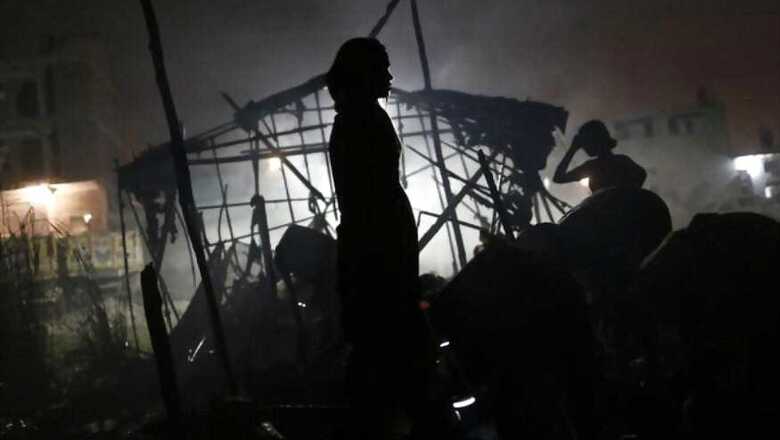
views
There are a few axiomatic truths about climate change. First among them is that climate change impacts people differently, based on their social and economic backgrounds. To put it in simpler terms, it has often been observed that those who contribute least to climate change, are often worst impacted by its effects.
This is most evident in big cities, where slum dwellers often suffer heavily because of climate change, despite their minimal contribution in causing it. Kavya Michael, an Associate Fellow at The Energy And Resources Institute (TERI) calls this paradoxical situation a violation of climate justice.
"Slums or informal settlements contribute least to the emissions," Michael told News18.com."In a way, waste picking done by slum dwellers is also an ecosystem service because they are cleaning up the city. But, the effects of climate change fall on slum dwellers heavily. This is a classic case of climate injustice," she added.
This paradox has been urgent part of the discourse across developing nations and there is a growing demand to deliver climate justice to marginalised rural communities, as well as the vast majority of urban poor.
Climate Justice is the way of viewing climate change through the lens of human rights, and to protect the rights of those who are most vulnerable to the climate crisis. For instance, slums which are often built on low-lying land are more vulnerable to flooding due to extreme weather events, as was seen in Mumbai floods in 2005 and more recently. They are also more vulnerable to extreme heat, due to urban heat pockets within cities and the negative impact of greenhouse gas emissions.
"Everyone needs to have an equal right to amenities and services that a city provides. But, those who live in these informal settlements, which are deemed illegal by the government, are mostly migrants. Therefore, they do not necessarily have access to the public distribution system. This reduces the entire support system they have,” Michael pointed out.
“For any kind of energy efficiency program to succeed, slum dwellers need to be educated about the effects of climate change, given a sense of ownership, which is basically, tenureship rights, and of course the right to the city," she added. Michael further said that civil societies too should play a major part in institutionalising these informal settlements in urban areas.
Slums aren’t the Problem
As per the 2011 Indian census, 65 million people (13.6 million families) lived in urban slums, while an additional 1.8 million were homeless. But, this massive population is often crammed into small places, skeletal structures, single-room homes with little or no access to clean water, sanitation or road networks. Treated as eyesores by a succession of city planners over centuries, sustainable architects point out a painful irony — these homes are inevitably energy efficient out of necessity.
"Slums need not be seen as a problem. They are, in fact, solutions that a formal housing system hasn't been able to provide in India," said Yatin Pandya, founder of Footprints E.A.R.T.H, an Ahmedabad based architecture firm.
"Almost half of Mumbai's population live in slums, and the area they occupy is roughly around twelve per cent, and still, we call them a problem?" asked Pandya. "I am not romanticising slums, but it is energy efficient. All they need is land and infrastructure, which of course the government can provide," he added.
Dharavi, for instance, has its own informal economy, which has massive turnovers and its own employment network. As a result, these slums function as workspaces with residential facilities reducing the need for slum dwellers to travel or take public transport.
Afroz Shah, a Mumbai based lawyer and environmentalist, also pointed out that these slums consume less, waste less and hence contribute less to the climate crisis. “If you analyse the reasons for global warming, the second-highest cause for it is food wastage," said Shah.
"I speak from my personal experience of working with slum dwellers on the ground level when I say there is far less food wastage in slum households. First of all, consumption is less, which also leads to less food wastage. So, their contribution to global warming for the reasons of food wastage is the bare minimum." he added.
"And what do the affluent section do? They lead a life of convenience, and they are not even debating the consequences of that life on the environment, and on the people like slum dwellers," pointed out Shah.
But Slums are the Worst Affected
Whether it’s an extreme-weather event or the less obvious, daily incremental harm, slums are inevitable the worst impacted due to climate change.
“Because of climate change, the rainfall density has increased, so floods happen more often, and the slums on the Mithi river bank are completely submerged underwater during those times. It is a painful sight to see. It is really unfortunate when the poor are told that they do not do anything for the planet when they have absolutely no resources to do wrong to this planet." said Shah.
These are compounded by health issues which are aggravated by climate change, with women and children being the worst impacted. “While both women and men in poverty suffer from climate change, gender discrimination means women have fewer resources to cope. Women retain the full burden of household chores, spending hours every day using low quality household solutions for lighting and cooking," said Alexie Seller, CEO, Pollinate Group, a social initiative operating in India, Nepal and Australia.
"The biggest health hazard is caused by kerosene used for lighting. Burning the fuel in poorly ventilated places contributes to indoor air pollution, the equivalent of smoking two packets of cigarettes per day. This causes premature death in women and young children," she added.
TERI Associate Fellow, Kavya Michael, also chimed in with Seller and said that firewood burning was a key issue that contribute to ailment, adding that “providing basic energy to them is very important. It also has to be sustainable. It is not like they want to burn firewood. But, they don't have choices.”
"The awareness level about climate change is less in women who live in slums," noted Kalyani Raj, Secretary-General, All India Women's Conference. "In Delhi slums, for example, many women are suffering from allergy problems, the reasons for which are generally waste accumulation in the surrounding areas, no proper sanitation system, and waterlogged drains which are mosquito breeding spots. But, they don't know that their health issues may be induced because of the environment," she added.
"A problem that all slum dwellers face is asthma, because of the rising pollution levels in Delhi. They are not aware that these issues are happening because of climate change and what are the solutions and preventions," said Raj.
All India Women's Conference recently organised a home-based waste management project in Rethala slums, Delhi, where they taught women to create manure out of waste.
"We worked with a small group of women, and when we explained the problems of waste, and its impact on climate change they could understand. We also told them that if they make manure, they can sell it…that seems to have incentivised them. So, in that way, we tackled the environmental issues, as well as their low-income problems," she added.
Solutions vs Demolitions
After decades of being allowed to grow, in spite of its illegality and hardly any interventions from the state, governments have often demolished these slums and/or moved them to the outskirts of the cities. “Demolishing, displacing, redeveloping from scratch are really very insensitive and primitive ways of integrating slums into the urban mainstream," said Rahul Srivastava, Urbanologist at Urbz, an experimental action and research collective operating at Mumbai, Bogota, Sao Paulo, Geneva and Seoul.
"If you look at how much effort people put in the improvement of their habitats, it becomes clear that so-called slums are actually huge collective capital, which must be recognized and allowed to grow. The idea is to develop without destroying existing social and economic relationships, so rather than using a tabula rasa approach, rebuilding can happen on a plot by plot basis. One house at a time or sometimes 2-3 houses could be rebuilt together," he added.
"Instead of helping slum dwellers, the government makes it more difficult to rebuild, through a very prejudiced set of regulations and a generally hostile and corrupt administration," pointed out another urbanologist from Urbz, Matias Echanove.
"Working with local residents and artisans of construction is a great way to produce sustainable models. In our experience of working with local contractors, who live and work in homegrown neighbourhoods, they are also very keen to absorb new technologies and reuse traditional techniques. It is mostly a question of cost,” Echanove added.
The urbanologist further said that if higher quality mud bricks were subsidized and made available, they would use them for sure. “They would also be keen on using solar panels if they were affordable in smaller sizes. They would be glad to connect taps to existing wells if they were allowed. The problem is fundamentally institutional. Homegrown neighbourhoods are already quite sustainable and are ready to become even more so," he added.
In fact, they can be an answer to India's urban housing problem. Despite schemes such as Pradhan Mantri Awas Yojana, that aims to provide affordable housing to 20 million urban poor within 2022, there are several other urban poor, who live in such homegrown neighbourhoods and are not covered under such schemes.
Developing homegrown neighbourhood if rebuild in a sustainable way can help mitigate climate crisis as well, while at the same time providing shelter for millions.
The Struggle for Resources
Both Srivastava and Echanove also pointed out that resources exist in such areas too, but are institutionally controlled and allocated.
"Water, for example, is already managed and rationed in cities such as Mumbai and can be further rationized on equitable terms between rich and poorer neighbourhoods, or industries and households. A large size of urban population already does with much less than others. The challenge will be to create more equitable modes of distribution." said Srivastava.
At the same time, many traditional modes of water conservation are more active in homegrown neighbourhoods pointed out Echanove. "These can be encouraged and supported so that on the supply side to resources can be sustainably enhanced. In one of our projects, experiments were conducted to connect existing wells to water-stressed toilets. Electricity is more complex but people across classes have to collectively find ways of more sustainable use of energy. The smaller size units in homegrown neighbourhoods are already one step closer to greater energy accountability which can be further encouraged," he added.
While there are many innovative solutions available to revamp slums and make them more sustainable than they already are, and also provide slum dwellers with support to deal with the effects of climate change, little resources have been provided to them so far.
"Slum Dwellers are just left on their own, as climatic conditions continue to get worse due to climate change," said Afroz Shah. Making a case for climate justice Shah pointed out, "At least the bare minimum of resources should be made available to them, and support must be forthcoming when they face vagaries of nature. But, it is not forthcoming, I must honestly tell you that it isn't."
This story is part of Covering Climate Now, a global collaboration of more than 250 news outlets to strengthen coverage of the climate story.


















Comments
0 comment